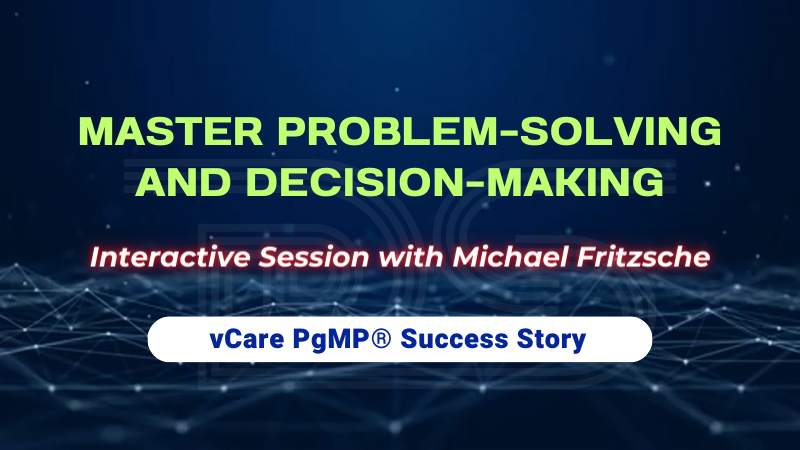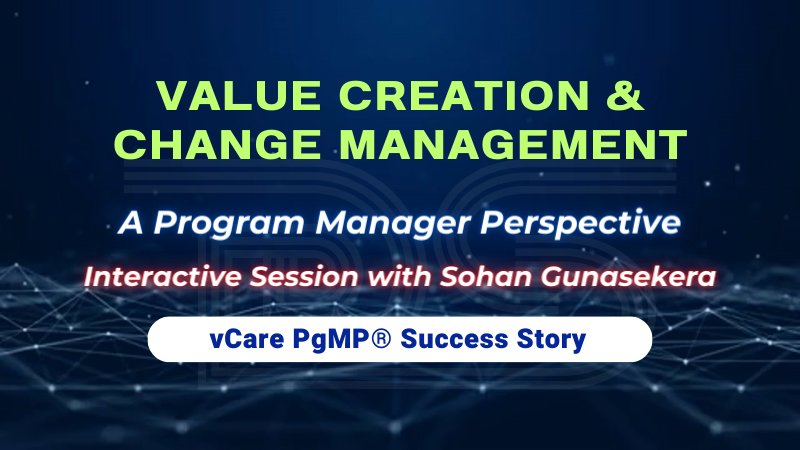
by Dharam CW2 | Apr 28, 2024 | Agile and Scrum Practices
🌟 Boost Your Agile Team’s Emotional Intelligence! 🌟
In our latest discussion on Agile and Emotional Intelligence, Justin Buckwalter, PfMP, PgMP, PMP, PMI-ACP, PMI-RMP and I uncover the pivotal role of EI in team success. In the rapidly evolving project environment, Emotional intelligence (EI) is not just a bonus—it’s essential. 🚀
🔍 Episode Highlights:
+ Understanding EI: Discover why Emotional Intelligence is crucial for team collaboration and effective decision-making.
+ Agile & EI Synergy: Learn how to apply Agile practices to boost EI in your teams.
+ Navigating Challenges: Explore strategies to overcome potential conflicts when integrating EI into team dynamics.
+ Emotional Agility: Enhance workplace and personal relationships through improved communication and understanding.
+ Leadership Through EI: Empower project managers to harness EI for better leadership and more productive teams.
🎧 Tune into our conversation and gain invaluable insights on enhancing your team’s emotional capabilities! Check out the episode now: https://lnkd.in/gJepXGbi
💬 Share your thoughts on Emotional Intelligence vs. Emotional Agility in our project environments. What challenges have you faced integrating EI into your projects?
🚀 Elevate Your Project Management Career:
– Register for my upcoming PgMP/PfMP Success Story Webinar: https://bit.ly/3TSx8fj
– Book an obligation-free consultation session on Project management Career, training, and certifications: http://talktodharam.com
– Discover training offers and certification discounts: https://bit.ly/3jWVepD
– Stay updated with our Q&A series and certification success stories by subscribing to the vCare Project Management YouTube channel at https://bit.ly/2YF0wJl
– Follow my podcasts and interviews with Project Management Experts on YouTube at https://bit.ly/2NDY8wd

by Dharam CW2 | Apr 2, 2024 | Program Management, Uncategorized
Join Justin Buckwalter, PfMP, PgMP, PMP, PMI-ACP, PMI-RMP and me in our latest episode as we explore the transformative journey “From Program Managers to Changemakers.” We discuss how program managers can evolve into forces of change, leading projects and teams toward impactful innovation. We also differentiate the roles of change managers and changemakers and uncover the strategies that drive successful organizational transformation. Additionally, we delve into the significance of the Agile Manifesto for changemakers and how they emerge as next-generation leaders in a VUCA (volatile, uncertain, complex, ambiguous) world. This episode is a must-watch for those ready to lead change and inspire their teams to do the same.
🔗 Watch now: https://youtu.be/QO4oR_wuZ0E
🚀 Elevate Your Project Management Career:
– Register for my upcoming PgMP/PfMP Success Story Webinar: https://bit.ly/3wEcztT
– Book an obligation-free consultation session on Project management Career, training, and certifications: http://talktodharam.com
– Discover training offers and certification discounts: https://bit.ly/3jWVepD
– Stay updated with our Q&A series and certification success stories by subscribing to the vCare Project Management YouTube channel at https://bit.ly/2YF0wJl
– Follow my podcasts and interviews with Project Management Experts on YouTube at https://bit.ly/2NDY8wd

by Dharam CW2 | Mar 27, 2024 | Professional Resilience and Inspiration Stories
Join me for an insightful webinar session with Janine Donohue, EPMO Director at NYCERS. This session targets Senior Professionals in Project, Program, and Portfolio Management, offering an unparalleled look into the transformative power of the Enterprise Project Management Office (EPMO).
This webinar will delve into:
– EPMO’s pivotal role as a change enabler and its influence on organizational value.
– Strategic considerations for EPMO structuring and enterprise integration.
– Guiding EPMO’s evolution within organizations to foster growth and adaptability.
– EPMO’s critical impact on reinforcing transformation cultures and achieving change management goals.
Why attend? Beyond the invaluable knowledge, earn 1 PDU to further your professional development.
🔗 Reserve your spot now: https://bit.ly/3wEcztT
Session Date: Thursday, 04th April 2024
Session Time: 10:00 AM – 11:00 AM (AKDT) / 11:00 AM – 12:00 PM (PDT) / 12:00 PM – 01:00 PM (MDT) / 01:00 PM – 02:00 PM (CDT) / 02:00 PM – 03:00 PM (EDT) / 03:00 PM – 04:00 PM (BRT) / 07:00 PM – 08:00 PM (BST) / 08:00 PM – 09:00 PM (CEST) / 09:00 PM – 10:00 PM (AST) / 10:00 PM – 11:00 PM (GST)
🚀 Elevate Your Project Management Career:
– Book an obligation-free consultation session on Project management Career, training, and certifications: http://talktodharam.com
– Discover training offers and certification discounts: https://bit.ly/3jWVepD
– Stay updated with our Q&A series and certification success stories by subscribing to the vCare Project Management YouTube channel at https://bit.ly/2YF0wJl
– Follow my podcasts and interviews with Project Management Experts on YouTube at https://bit.ly/2NDY8wd

by Dharam CW2 | Mar 9, 2024 | Professional Development Webinars
Join me for an exclusive webinar where Michael Fritzsche, a distinguished Project, Program, and Portfolio Management professional in the automation industry from Rheinböllen, Rhineland-Palatinate, Germany, will share his journey and experiences, offering attendees a unique perspective on overcoming challenges and leading strategic projects.
Key topics to be covered include:
– Equipping Senior Managers for Strategic Decision-Making.
– The Dynamics of Human Judgment vs. Algorithms in Decision-Making.
– Best Practices for Building Stakeholder Trust and Credibility.
– Effective Use of Deadlines to Boost Productivity.
🔗 Reserve your spot now: https://bit.ly/3ON2Ibl
Session Date: 21st March 2024
Session Time: 09:30 AM – 10:30 AM (PDT) / 10:30 AM – 11:30 AM (MDT) / 11:30 – 12:30 PM (CDT) / 12:30 PM – 01:30 PM (EDT) / 01:30 PM – 02:30 PM (BRT) / 04:30 PM – 05:30 PM (GMT) / 05:30 PM – 06:30 PM (CET) / 07:30 PM – 08:30 PM (AST) / 08:30 PM – 09:30 PM (GST) / 10:00 PM – 11:30 PM (IST)
🚀 Elevate Your Project Management Career:
– Book an obligation-free consultation session on Project management Career, training, and certifications: http://talktodharam.com
– Discover training offers and certification discounts: https://bit.ly/3jWVepD
– Stay updated with our Q&A series and certification success stories by subscribing to the vCare Project Management YouTube channel at https://bit.ly/2YF0wJl
– Follow my podcasts and interviews with Project Management Experts on YouTube at https://bit.ly/2NDY8wd

by Dharam CW2 | Mar 3, 2024 | Professional Development Webinars
🌟 Exciting Webinar Alert! 🌟
I’m delighted to invite you to a special webinar where we’ll delve into the nuances of transformative project leadership. I’m your host, and joining us is the esteemed Sohan Gunasekera from Melbourne, Australia, a visionary in Project, Program, and Portfolio Management.
In this session, Sohan will share his profound insights on:
– The impact of short-term corporate gratification on organizational goals.
– The importance of sustained investments for long-term organizational performance.
– Various approaches to culture transformation.
– Essential change leadership competencies for program managers.
– Best practices for managing diverse teams in change management.
– Strategies for influencing transformation through mindset and behavior changes.
🔗 Reserve your spot now: https://bit.ly/4bd68h8
Session Date & Time:
07th Mar’24 (Americas)
06:30 PM – 07:30 PM (PST) / 07:30 PM – 08:30 PM (MST) / 08:30 PM – 09:30 PM (CST) / 09:30 PM – 10:30 PM (EST)
08th Mar’24 (ASEAN & Oceania)
09:30 AM – 10:30 AM (WIB) / 10:30 AM – 11:30 AM (SGT/MYT) / 11:30 AM – 12:30 PM (JST/KST) / 12:30 PM – 01:30 PM (AEST) / 01:30 PM – 02:30 PM (AEDT) / 03:30 PM -04:30 PM (NZDT)
As a mentor, I’ve had the privilege of guiding Sohan through his PgMP exam journey, and he’s here to pass on that knowledge. It’s an opportunity for all project management professionals to earn 1 PDU and elevate your expertise.
Take advantage of this chance to enhance your skills and broaden your project management horizon.
🚀 Elevate Your Project Management Career:
– Book an obligation-free consultation session on Project management Career, training, and certifications: http://talktodharam.com
– Discover training offers and certification discounts: https://bit.ly/3jWVepD
– Stay updated with our Q&A series and certification success stories by subscribing to the vCare Project Management YouTube channel at https://bit.ly/2YF0wJl
– Follow my podcasts and interviews with Project Management Experts on YouTube at https://bit.ly/2NDY8wd











Recent Comments